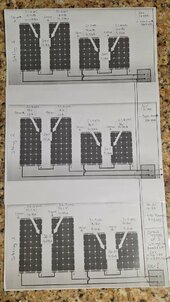Hi, I am upgrading from a 12V system to 24V (replacing 12V-3500W inverter to 24V-4000W LFP inverter and connecting two 12V - 300AH batteries in series with a Victron battery balancer - having to remove the 3rd 12V- 300AH battery) and will redesign my existing panels for my 80 AMP/200V 12/24/36/48v Controller.
My panel redesign will be 3 strings of series/parallel with the slightly off string being #3 (the volts - matching Lowest Common Denominator, 36.3V), then parallel those 3 strings together (36V x 48.73A = 1754.28 Watts).
Big question - will my total VOC (bottom right corner as a question mark) also be Lowest Common Denominator (86.4 VOC) or am I wrong on the Voltage and its actually Highest Common Denominator (87.8 VOC)?
Panel fuses, etc... will be applied, just not noted.
Picture attached.
Thanks in advance!
My panel redesign will be 3 strings of series/parallel with the slightly off string being #3 (the volts - matching Lowest Common Denominator, 36.3V), then parallel those 3 strings together (36V x 48.73A = 1754.28 Watts).
Big question - will my total VOC (bottom right corner as a question mark) also be Lowest Common Denominator (86.4 VOC) or am I wrong on the Voltage and its actually Highest Common Denominator (87.8 VOC)?
Panel fuses, etc... will be applied, just not noted.
Picture attached.
Thanks in advance!




